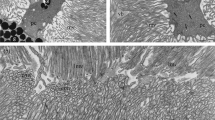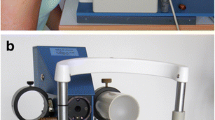Summary
Azide, which is known to affect the pigment epithelium strongly may be assumed to cause damage to the receptors, which are functionally connected to the pigment epithelium. To check this hypothesis the effect of azide on the ERG was investigated. An isolated retina preparation was used as in this preparation the P III component, which contains considerable receptor contribution, can be isolated.
In 2 series of experiments the effects of azide on the P III and the complete ERG were investigated. Depending on the concentration azide was shown to abolish the b-wave, to cause delay and amplitude diminution of the P III and enhance a positive component in the off-effect.
A number of plausible sites of origin of these azide effects on the ERG changes are discussed.
Similar content being viewed by others
References
Brown, K. T.: The electroretinogram: its components and their origins. Vision Res.8, 633–677 (1968)
Cervetto, L., McNichol, E. F.: Inactivation of horizontal cells in turtle retina by glutamate and aspartate. Science178, 767–768 (1972)
Hanitzsch, R.: Intraretinal isolation of P III subcomponents in the isolated rabbit retina after treatment with sodium aspartate. Vision Res.13, 2093–2102 (1973)
Hanitzsch, R., Bornschein, H.: Spezielle Überlebensbedingungen für isolierte Netzhäute verschiedener Warmblüter. Experientia (Basel)21, 484–486 (1965)
Lützow, A. v., Wündsch, L.: Grenzen zeitlicher Summation im Doppelreiz-ERG des Kaninchens. Vision Res.7, 565–571 (1967)
Miller, R. F., Dowling, J. E.: A relationship between Müller cell slow potentials and the ERG b-wave. Proc. VIII. Symp. ISCERG, pp. 85–100, Pisa, Pacini (1972)
Murakami, M., Kaneko, A.: Differentiation of P III subcomponents in cold-blooded vertebrate retinas. Vision Res.6, 627–636 (1966)
Noell, W. K.: Studies on the electrophysiology and the metabolism of the retina. Project Rep. 21-1201-0004 No 1, USA Air Force School of Aviation Medicine, Randolph Field, Texas (1953)
Pautler, E. L., Murakami, M., Nosaki, H.: Differentiation of P III subcomponents in isolated mammalian retinas. Vision Res.8, 489–491 (1968)
Penn, R. D., Hagins, W. A.: Signal transmission along retinal rods and the origin of the electroretinographic a-wave. Nature (Lond.)223, 201–205 (1969)
Tomita, T., Electrical activity in the vertebrate retina. J. Opt. Soc. Amer.53, 49–57 (1963)
Wündsch, L., Lützow, A. v.: The effect of aspartate on the ERG of the isolated rabbit retina. The visual system: Neurophysiology, Biophysics and Their Clinical Applications, pp. 95–99, New York: Plenum Publi. Corp. 1972
Wündsch, L., Lützow, A. v., Reuter, J. H.: Nachweis des Azid-Potentials an der isolierten Kaninchennetzhaut. Experientia (Basel)30, 627–628 (1974)
Author information
Authors and Affiliations
Additional information
Supported by a “Netherlands Organization for the Advancement of Pure Research” grant.
Rights and permissions
About this article
Cite this article
Wündsch, L., v. Lützow, A. & Reuter, J.H. Effect of azide on the ERG of the isolated mammalian retina. Pflugers Arch. 356, 237–244 (1975). https://doi.org/10.1007/BF00583835
Received:
Issue Date:
DOI: https://doi.org/10.1007/BF00583835




